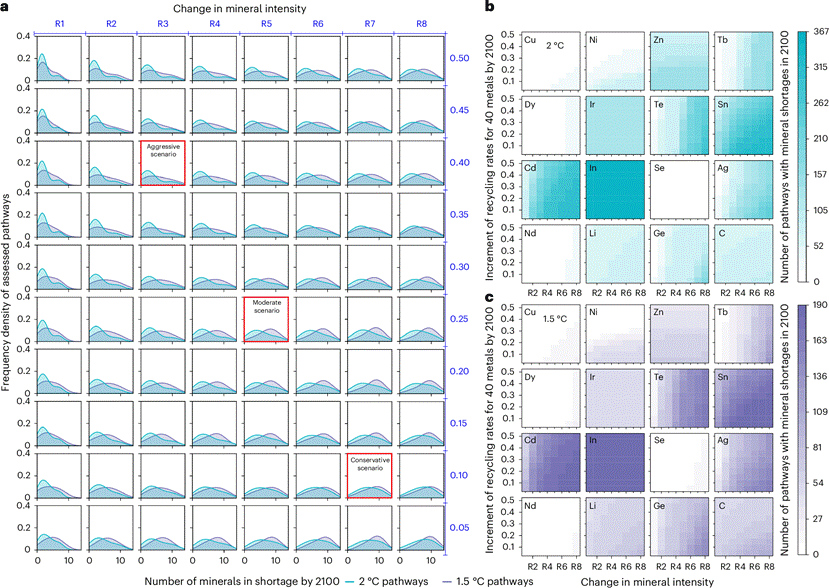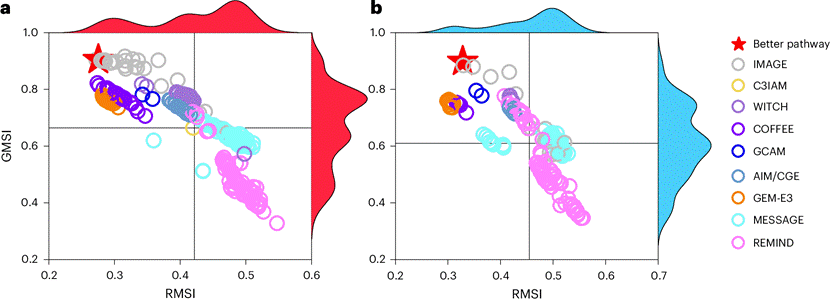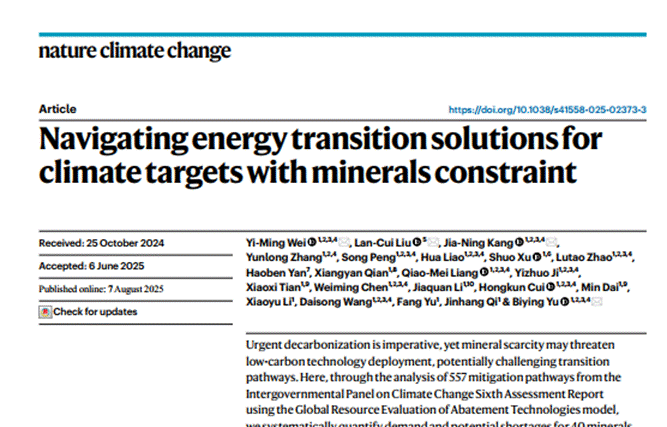
The research team led by Professor Wei Yi-Ming at the Beiing Lab for System Engineering of Carbon Neutrality, Beijing Institute of Technology (BIT) has, for the first time internationally, proposed a low-carbon energy transition pathway that simultaneously considers emissions reduction, mineral resource security, and regional equity. This provides a robust scientific foundation for achieving climate targets while safeguarding mineral resource security under global resource constraints.
The study, titled “Navigating energy transition solutions for climate targets with minerals constraint”, was published online on August 8, 2025 (Beijing time) in Nature Climate Change as a Research Article and was also selected as a Research Highlight by the journal. Following its publication, the work has received coverage from leading domestic and international media outlets. This marks the 10th research article that Professor Wei’s team has published in Nature sub-journals since 2017.
With the intensification of global warming, accelerating the energy system transition is essential to meet the temperature-control targets set out in the Paris Agreement. While many integrated assessment models (IAMs) have already proposed extensive emissions reduction pathways consistent with 1.5 °C and 2 °C targets, these pathways heavily rely on a range of low-carbon technologies. Yet, the manufacturing of such technologies depends on a wide spectrum of critical mineral resources. Complex interlinkages exist between climate targets, technology deployment, and mineral demand across temporal and spatial scales. However, these relationships have not been systematically examined from a mechanistic and structural perspective, leaving critical gaps in current transition planning.
To address this gap, Professor Wei Yi-Ming and his team advanced their earlier the China’s Climate Change Integrated Assessment Model (C3IAM) by developing a new model: the Global Resource Evaluation of Abatement Technologies (GREAT). Using GREAT, the team conducted a panoramic analysis of 80 technology progress scenarios, systematically quantifying the global and regional demand for 40 critical minerals—along with associated shortage risks—across 17 energy technologies embedded in the 557 mitigation pathways from the IPCC Sixth Assessment Report (AR6) (Figure 1). Based on this analysis, the researchers identified the optimal mitigation pathway with the lowest mineral shortage risks (Figure 2). They further proposed a dual-track quantitative response strategy centered on resource sustainability to address remaining global and regional mineral supply risks along this optimal pathway.
The findings emphasize that achieving deep decarbonization requires more than technological innovation alone. Effective responses to mineral constraints demand a diversified portfolio of energy technologies, enhanced recycling and material substitution, deeper global trade cooperation, and maintaining moderate economic growth. These measures together can mitigate systemic risks from mineral shortages and ensure the realization of climate goals.

Figure 1. Global mineral shortage projections under 80 technology progress scenarios by 2100.

Figure 2.Synergistic evaluation of mineral security and climate target achievement across 557 mitigation pathways.
The paper lists Professor Wei Yi-Ming, Professor Yu Biying, and Associate Professor Kang Jianing (Beijing Institute of Technology), along with Professor Liu Lanchui (Beijing Normal University), as corresponding authors. This research was supported by the National Natural Science Foundation of China (NSFC) Science Center Program, NSFC Major Program, and the Carbon Neutral Systems Engineering Beijing Laboratory.
Reference:Wei, Y. M., Liu, L. C., Kang, J. N., Yu, B. Y., et al. (2025). Navigating energy transition solutions for climate targets with minerals constraint. Nature Climate Change, 15, 833–841. https://doi.org/10.1038/s41558-025-02373-3
Full text available at:https://www.nature.com/articles/s41558-025-02373-3.
